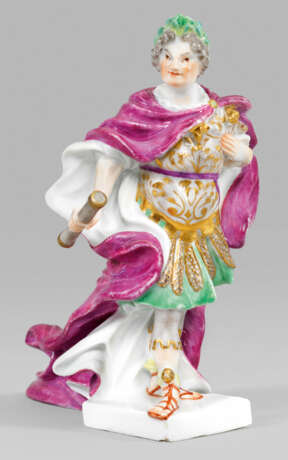ID 942982
Lot 2363 | Museale, seltene Meissen Statuette von August dem Starken
Estimate value
€ 9 800 – 19 600
als römischer Imperator
Böttgerporzellan. Auf einer quadratischen Plinthe in stolzer, majestätisch voranschreitender Haltung stehender Friedrich August I., Kurfürst von Sachsen und als August II. König von Polen, den Kopf nach rechts gedreht. Das grau gepuderte Haar ist mit einem Lorbeerkranz bekrönt. Gekleidet in eine römische Imperatorentracht aus Küraß über seegrünem Unterkleid und Schurzhosen. Bedeckt von einem, in großen Falten, weit herabfallenden, purpurfarbenen Königsmantel. Sich mit der linken Hand an die Brust greifend, in der Rechten den Marschallstab haltend. Polychrome Malerei mit reichem Golddekor. Farbstaffierung von Georg Funke. Entw. Johann Joachim Kretzschmar. Meissen. Um 1715 - 1720. H. 10,5 cm.
Ausgesprochen seltene Königsstatuette aus der Frühzeit der Meissener Manufaktur, die in drei unterschiedlichen Versionen nachzuweisen ist: In "Teütscher Kleidung" in Steinzeug bzw. in Böttgerporzellan sowie in römischen Habit in Böttgerporzellan. Die ursprünglich als Königsfigur eines Schachspiels entworfene Modell ist mit sichtbar majestätischem Habitus, im Moment des energisch-dynamischen Voranschreitens des Regenten wiedergegeben. Der in übermäßig großer Stofflichkeit modellierte Königsmantel, der Marschallstab sowie der das Haupt bekrönende Lorbeerkranz sind die unverkennbaren Herrscherinsignien und legitimieren Status und Würde August des Starken. Der Modelleur Johann Joachim Kretzschmar (1677 – 1740), Schüler des bedeutenden Dresdner Bildhauers Balthasar Permoser und späterer Hofbildhauer verstand es, die charakteristischen Züge des kraftstrotzenden Monarchen („der Starke“) zu porträtieren. Das ursprüngliche Modell ist die erste figürliche Ausformung von August dem Starken in Porzellan, die zudem vom König selbst in Auftrag gegeben wurde. Lt. Inventaren des königlichen Warenlagers von 1719 wurde nur eine geringe Anzahl von Figuren ausgeformt. Daher ist sie eine Rarität auf dem nationalen und internationalen Kunstmarkt.
Vgl. Broschüre Langeloh porcelain, August der Starke als römischer Imperator, S. 3ff.; Berling, S. 38 mit Abb. 60; Kat. Cassirer/Helbing, Slg. Gumprecht, 1918, Nr. 294; SKD, Inv.-Nr.: PE 3797.
A very rare museum figurine of August the Strong as Roman imperator. One of the earliest royal figurines executed in Boettger porcelain.
Meissen. Um 1715 - 1720.
| Manufactur: | Meissen Porcelain Factory |
|---|---|
| Auction house category: | Porcelain |
| Manufactur: | Meissen Porcelain Factory |
|---|---|
| Auction house category: | Porcelain |
| Address of auction |
Kunstauktionshaus Schloss Ahlden GmbH Große Str. 1 29691 Ahlden(Aller) Germany | ||||||||||||||
|---|---|---|---|---|---|---|---|---|---|---|---|---|---|---|---|
| Preview |
| ||||||||||||||
| Phone | +49 5164 80100 | ||||||||||||||
| Buyer Premium | 25.0 | ||||||||||||||
| Conditions of purchase | Conditions of purchase | ||||||||||||||
| Business hours | Business hours
|



